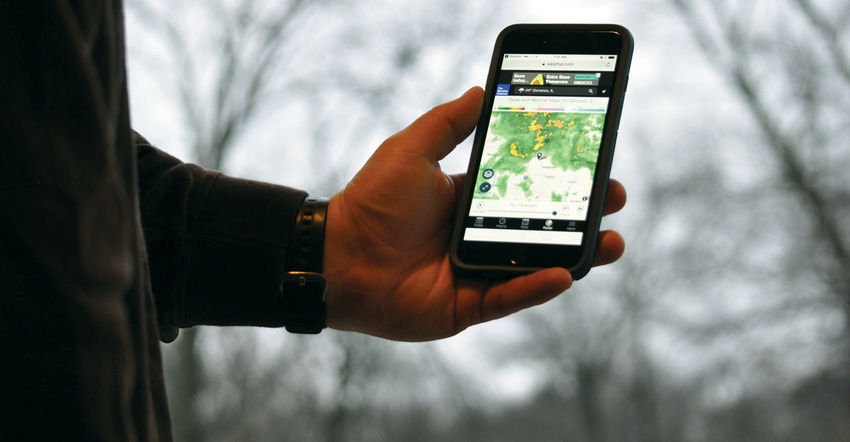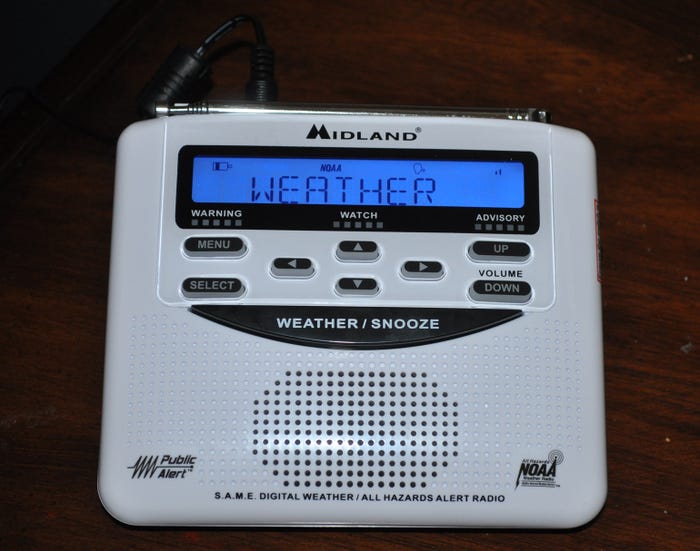
Illinois averages 31 tornadoes per year, and springtime is peak tornado season, according to the Illinois Soil and Water Survey. Two years ago, the devastating E4 Fairdale tornado destroyed homes, barns and communities in northern Illinois; last year, a tornado took out homes and barns in western Illinois, including the McGrew family’s beautiful old draft horse barn.
With most farm families living, working and sleeping well outside of earshot from severe weather sirens, how can they effectively track severe weather and hear warnings — especially at night?
We asked that question on Twitter recently, and several folks weighed in:
• @FarmChicJodi
Many farmers and rural residents track severe weather warnings with digital tools like Twitter and severe weather apps. They’re confident the apps work. How often have you heard smartphone alerts erupt in the middle of a meeting or a church service? You think you’re safe. Right?
Maybe, says Patrick Marsh, warning coordination meteorologist at the National Storm Prediction Center. But what happens if the cell tower goes out or you lose internet service? Severe weather apps need an internet connection to work, he explains, and cellphone and internet providers can lose power during storms. If you do reach for a digital warning system, Marsh says to use severe weather apps from a trustworthy source and have a backup option during storms.
“The National Weather Service is tasked with the protection of life and property,” he explains. “Forecast offices are staffed with at least two people 24/7. We’re always watching and putting out information.”
That’s why many weather apps tap into the National Weather Service’s warning system, Marsh explains, and pass that information on to subscribers. Weather apps are essentially the middleman that may not wake you up in the middle of the night when power and internet service are in jeopardy.
Here are Marsh’s five recommendations for reliable severe weather information, regardless of where you live:
1. Kick it old-school with an NOAA weather radio. “The National Weather Service may not be flashiest, but we’re tried-and-true,” Marsh says. He recommends a battery-powered National Oceanic and Atmospheric Administration all-hazard weather radio for dependable weather information. How dependable? Marsh relied on his weather radio while chasing a hurricane.
Weather radios can be turned off when Mother Nature cooperates, but Marsh advises keeping them on whenever possible. Weather radios push out Amber Alerts and other civil emergency information, should the need arise. NOAA all-hazard radios are programmed according to your county’s Federal Information Processing Standards (FIPS) code and act as your very own indoor siren when watches and warnings are issued, Marsh notes.

STICK WITH A CLASSIC: Patrick Marsh recommends a battery-powered NOAA all-hazard weather radio for dependable weather information. “The National Weather Service may not be flashiest, but we’re tried-and-true,” he says.

2. Reach for the TV remote. “Assuming your power is on, your local television station and local meteorologist is another tried-and-true method,” Marsh explains.
3. Crank up the radio. If you have a battery-powered radio, Marsh says many TV stations have partnership agreements with local radio stations to simulcast during power outages.
4. Log onto the NWS website. If you’re blessed with power and internet service during a storm, Marsh recommends weather.gov, where you can point and click your way to local forecasts and warnings.
5. Remember “Ready, set, go.” It’s all about your game plan. The National Weather Service’s convective outlook indicates the slight to high risk of severe storms across the U.S. “That’s the big picture,” Marsh explains. When confidence levels strengthen and severe weather is highly probable, Marsh and the Storm Prediction Center issue a severe thunderstorm or tornado watch by county. “When a phenomenon becomes imminent, we’ll issue a severe thunderstorm or tornado warning,” he explains. “It’s a ‘ready, set, go’ process. The convective outlook is the ‘ready’ piece, the watch is the ‘set’ piece, and the warning is the ‘go’ piece.”
When the convective outlook indicates a moderate to high risk for storms, Marsh recommends thinking about your activities for the day and planning a safe course of action if you’re outside or in the field when severe weather strikes. When a watch is issued, be prepared to act on your plan. When warnings sound or sirens blare, it’s go time. “That’s not the time to figure out what you’re going to do; that’s the time to take action,” he says. “In some cases, you may only have minutes.”
About the Author(s)
You May Also Like




